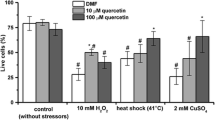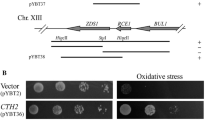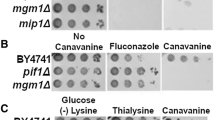Abstract
The molecular mechanisms involved in the ability of yeast cells to adapt and respond to oxidative stress are of great interest to the pharmaceutical, medical, food, and fermentation industries. In this study, we investigated the time-dependent, cellular redox homeostasis ability to adapt to menadione-induced oxidative stress, using biochemical and proteomic approaches in Saccharomyces cerevisiae KNU5377. Time-dependent cell viability was inversely proportional to endogenous amounts of ROS measured by a fluorescence assay with 2′,7′-dichlorofluorescin diacetate (DCFHDA), and was hypersensitive when cells were exposed to the compound for 60 min. Morphological changes, protein oxidation and lipid peroxidation were also observed. To overcome the unfavorable conditions due to the presence of menadione, yeast cells activated a variety of cell rescue proteins including antioxidant enzymes, molecular chaperones, energy-generating metabolic enzymes, and antioxidant molecules such as trehalose. Thus, these results show that menadione causes ROS generation and high accumulation of cellular ROS levels, which affects cell viability and cell morphology and there is a correlation between resistance to menadione and the high induction of cell rescue proteins after cells enter into this physiological state, which provides a clue about the complex and dynamic stress response in yeast cells.
Similar content being viewed by others
References
Alic, N., T. Felder, M.D. Temple, C. Gloeckner, V.J. Higgins, P. Briza, and I.W. Dawes. 2004. Genome-wide transcriptional responses to a lipid hydroperoxide: adaptation occurs without induction of oxidant defenses. Free Radic. Biol. Med. 37, 23–35.
Alvarez-Peral, F.J., O. Zaragoza, Y. Pedreno, and J.C. Arguelles. 2002. Protective role of trehalose during severe oxidative stress caused by hydrogen peroxide and the adaptive oxidative stress response in Candida albicans. Microbiology 148, 2599–2606.
Aranda, A., A. Querol, and M. del Olmo. 2002. Correlation between acetaldehyde and ethanol resistance and expression of HSP genes in yeast strains isolated during the biological aging of sherry wines. Arch. Microbiol. 177, 304–312.
Benaroudj, N., D.H. Lee, and A.L. Goldberg. 2001. Trehalose accumulation during cellular stress protects cells and cellular proteins from damage by oxygen radicals. J. Biol. Chem. 276, 24261–24267.
Beriault, R., D. Chenier, R. Singh, J. Middaugh, R. Mailloux, and V. Appanna. 2005. Detection and purification of glucose 6-phos phate dehydrogenase, malic enzyme, and NADP-dependent isocitrate dehydrogenase by blue native polyacrylamide gel electrophoresis. Electrophoresis 26, 2892–2897.
Brosnan, M.P., D. Donnelly, T.C. James, and U. Bond. 2000. The stress response is repressed during fermentation in brewery strains of yeast. J. Appl. Microbiol. 88, 746–755.
Cabiscol, E., G. Belli, J. Tamarit, P. Echave, E. Herrero, and J. Ros. 2002. Mitochondrial Hsp60, resistance to oxidative stress, and the labile iron pool are closely connected in Saccharomyces cerevisiae. J. Biol. Chem. 277, 44531–44538.
Carrasco, P., A. Querol, and M. del Olmo. 2001. Analysis of the stress resistance of commercial wine yeast strains. Arch. Microbiol. 175, 450–457.
Cashikar, A.G., M. Duennwald, and S.L. Lindquist. 2005. A chaperone pathway in protein disaggregation. Hsp26 alters the nature of protein aggregates to facilitate reactivation by Hsp104. J. Biol. Chem. 280, 23869–23875.
Castro, F.A., R.S. Herdeiro, A.D. Panek, E.C. Eleutherio, and M.D. Pereira. 2007. Menadione stress in Saccharomyces cerevisiae strains deficient in the glutathione transferases. Biochim. Biophys. Acta. 1770, 213–220.
Costa, V. and P. Moradas-Ferreira. 2001. Oxidative stress and signal transduction in Saccharomyces cerevisiae: insights into ageing, apoptosis and diseases. Mol. Aspects Med. 22, 217–246.
Echave, P., J. Tamarit, E. Cabiscol, and J. Ros. 2003. Novel antioxidant role of alcohol dehydrogenase E from Escherichia coli. J. Biol. Chem. 278, 30193–30198.
Estruch, F. 2000. Stress-controlled transcription factors, stress-induced genes and stress tolerance in budding yeast. FEMS Microbiol. Rev. 24, 469–486.
Fernandes, P.N., S.C. Mannarino, C.G. Silva, M.D. Pereira, A.D. Panek, and E.C. Eleutherio. 2007. Oxidative stress response in eukaryotes: effect of glutathione, superoxide dismutase and catalase on adaptation to peroxide and menadione stresses in Saccharomyces cerevisiae. Redox Rep. 12, 236–244.
Francois, J. and J.L. Parrou. 2001. Reserve carbohydrates metabolism in the yeast Saccharomyces cerevisiae. FEMS Microbiol. Rev. 25, 125–145.
Fujita, K., R. Kawai, H. Iwahashi, and Y. Komatsu. 1998. Hsp104 responds to heat and oxidative stress with different intracellular localization in Saccharomyces cerevisiae. Biochem. Biophys. Res. Commun. 248, 542–547.
Gasch, A.P., P.T. Spellman, C.M. Kao, O. Carmel-Harel, M.B. Eisen, G. Storz, D. Botstein, and P.O. Brown. 2000. Genomic expression programs in the response of yeast cells to environmental changes. Mol. Biol. Cell 11, 4241–4257.
Gibson, B.R., S.J. Lawrence, J.P. Leclaire, C.D. Powell, and K.A. Smart. 2007. Yeast responses to stresses associated with industrial brewery handling. FEMS Microbiol. Rev. 31, 535–569.
Grabowska, D. and A. Chelstowska. 2003. The ALD6 gene product is indispensable for providing NADPH in yeast cells lacking glucose-6-phosphate dehydrogenase activity. J. Biol. Chem. 278, 13984–13988.
Haslbeck, M., N. Braun, T. Stromer, B. Richter, N. Model, S. Weinkauf, and J. Buchner. 2004. Hsp42 is the general small heat shock protein in the cytosol of Saccharomyces cerevisiae. EMBO J. 23, 638–649.
Herdeiro, R.S., M.D. Pereira, A.D. Panek, and E.C. Eleutherio. 2006. Trehalose protects Saccharomyces cerevisiae from lipid peroxidation during oxidative stress. Biochim. Biophys. Acta 1760, 340–346.
Herrero, E., J. Ros, G. Belli, and E. Cabiscol. 2008. Redox control and oxidative stress in yeast cells. Biochim. Biophys. Acta. 1780, 1217–1235.
Horak, C.E. and M. Snyder. 2002. Global analysis of gene expression in yeast. Funct. Integr. Genomics 2, 171–180.
Jamieson, D.J. 1998. Oxidative stress responses of the yeast Saccharomyces cerevisiae. Yeast 14, 1511–1527.
Jelinsky, S.A. and L.D. Samson. 1999. Global response of Saccharomyces cerevisiae to an alkylating agent. Proc. Natl. Acad. Sci. USA 96, 1486–1491.
Kim, I., H. Yun, and I. Jin. 2007a. Comparative proteomic analyses of the yeast Saccharomyces cerevisiae KNU5377 strain against menadione-induced oxidative stress. J. Microbiol. Biotechnol. 17, 207–217.
Kim, I.S., H.S. Yun, S.H. Kwak, and I.N. Jin. 2007b. The physiological role of CPR1 in Saccharomyces cerevisiae KNU5377 against menadione stress by proteomics. J. Microbiol. 45, 326–332.
Kim, I.S., H.S. Yun, I.S. Park, H.Y. Sohn, H. Iwahashi, and I.N. Jin. 2006. A knockout strain of CPR1 induced during fermentation of Saccharomyces cerevisiae KNU5377 is susceptible to various types of stress. J. Biosci. Bioeng. 102, 288–296.
Le Moan, N., G. Clement, S. Le Maout, F. Tacnet, and M.B. Toledano. 2006. The Saccharomyces cerevisiae proteome of oxidized protein thiols: contrasted functions for the thioredoxin and glutathione pathways. J. Biol. Chem. 281, 10420–10430.
Lopez-Mirabal, H.R. and J.R. Winther. 2008. Redox characteristics of the eukaryotic cytosol. Biochim. Biophys. Acta 1783, 629–640.
Lushchak, V.I. and D.V. Gospodaryov. 2005. Catalases protect cellular proteins from oxidative modification in Saccharomyces cerevisiae. Cell Biol. Int. 29, 187–192.
Machida, K., T. Tanaka, and M. Taniguchi. 1999. Depletion of glutathione as a cause of the promotive effects of polygodial, a sesquiterpene on the production of reactive oxygen species in Saccharomyces cerevisiae. J. Biosci. Bioeng. 88, 526–530.
Moradas-Ferreira, P. and V. Costa. 2000. Adaptive response of the yeast Saccharomyces cerevisiae to reactive oxygen species: defences, damage and death. Redox Rep. 5, 277–285.
Navarro-Avino, J.P., R. Prasad, V.J. Miralles, R.M. Benito, and R. Serrano. 1999. A proposal for nomenclature of aldehyde dehydrogenases in Saccharomyces cerevisiae and characterization of the stress-inducible ALD2 and ALD3 genes. Yeast 15, 829–842.
Parrou, J.L. and J. Francois. 1997. A simplified procedure for a rapid and reliable assay of both glycogen and trehalose in whole yeast cells. Anal. Biochem. 248, 186–188.
Querol, A., M.T. Fernandez-Espinar, M. del Olmo, and E. Barrio. 2003. Adaptive evolution of wine yeast. Int. J. Food Microbiol. 86, 3–10.
Reverter-Branchat, G., E. Cabiscol, J. Tamarit, and J. Ros. 2004. Oxidative damage to specific proteins in replicative and chronological-aged Saccharomyces cerevisiae: common targets and prevention by calorie restriction. J. Biol. Chem. 279, 31983–31989.
San Miguel, P.F. and J.C. Arguelles. 1994. Differential changes in the activity of cytosolic and vacuolar trehalases along the growth cycle of Saccharomyces cerevisiae. Biochim. Biophys. Acta 1200, 155–160.
Sirisattha, S., Y. Momose, E. Kitagawa, and H. Iwahashi. 2004. Toxicity of anionic detergents determined by Saccharomyces cerevisiae microarray analysis. Water Res. 38, 61–70.
Thorpe, G.W., C.S. Fong, N. Alic, V.J. Higgins, and I.W. Dawes. 2004. Cells have distinct mechanisms to maintain protection against different reactive oxygen species: oxidative-stress-response genes. Proc. Natl. Acad. Sci. USA 101, 6564–6569.
Tucker, C.L. and S. Fields. 2004. Quantitative genome-wide analysis of yeast deletion strain sensitivities to oxidative and chemical stress. Comp. Funct. Genomics 5, 216–224.
Voit, E.O. 2003. Biochemical and genomic regulation of the trehalose cycle in yeast: review of observations and canonical model analysis. J. Theor. Biol. 223, 55–78.
Zadzinski, R., A. Fortuniak, T. Bilinski, M. Grey, and G. Bartosz. 1998. Menadione toxicity in Saccharomyces cerevisiae cells: activation by conjugation with glutathione. Biochem. Mol. Biol. Int. 44, 747–759.
Zuzuarregui, A. and M.L. del Olmo. 2004. Expression of stress response genes in wine strains with different fermentative behavior. FEMS Yeast Res. 4, 699–710.
Author information
Authors and Affiliations
Corresponding authors
Rights and permissions
About this article
Cite this article
Kim, IS., Sohn, HY. & Jin, I. Adaptive stress response to menadione-induced oxidative stress in Saccharomyces cerevisiae KNU5377. J Microbiol. 49, 816–823 (2011). https://doi.org/10.1007/s12275-011-1154-6
Received:
Accepted:
Published:
Issue Date:
DOI: https://doi.org/10.1007/s12275-011-1154-6




